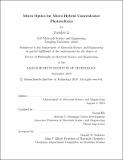| dc.contributor.advisor | Juejun Hu. | en_US |
| dc.contributor.author | Li, Duanhui. | en_US |
| dc.contributor.other | Massachusetts Institute of Technology. Department of Materials Science and Engineering. | en_US |
| dc.date.accessioned | 2020-01-23T16:56:47Z | |
| dc.date.available | 2020-01-23T16:56:47Z | |
| dc.date.copyright | 2019 | en_US |
| dc.date.issued | 2019 | en_US |
| dc.identifier.uri | https://hdl.handle.net/1721.1/123563 | |
| dc.description | This electronic version was submitted by the student author. The certified thesis is available in the Institute Archives and Special Collections. | en_US |
| dc.description | Thesis: Ph. D., Massachusetts Institute of Technology, Department of Materials Science and Engineering, 2019 | en_US |
| dc.description | Cataloged from student-submitted PDF version of thesis. | en_US |
| dc.description | Includes bibliographical references (pages 113-124). | en_US |
| dc.description.abstract | Concentrating photovoltaics (CPV) systems use concentrating optical elements to significantly reduce the material and processing costs of multi-junction high efficiency solar cells and improve the conversion efficiency. However, several issues hindered the development of CPV technologies due to the fundamental limit of thermodynamics and practical difficulties of manufacturing and deployment, such as system bulkiness, tight tracking error, thermal management and inability to collect diffuse irradiance. By dramatically scaling down the dimensions of the cells to the level of hundreds of microns and accordingly the concentrating optics, micro hybrid CPV overcomes the listed issues and also delivers a small form factor module prole similar to conventional at panel PV. In this thesis, we are focusing on the critical optical components in the micro hybrid CPV: the micro optics. First, we demonstrated a wafel-level micro hybrid CPV module based on Si fabrication. | en_US |
| dc.description.abstract | By introducing the micro cavities in Si wafer with wet etching, this novel micro optical element illustrates its potential for cost-eective collection of both direct and diffuse sunlight, thereby extending the geographic and market domains for cost-eective PV system deployment. By improving the CPV figure of merit by 46%, our micro hybrid CPV module demonstrated state-of-the-art small-form-factor CPV module optical performance. Next, we focused on developing a micro-prism-array based low-prole spectrum splitting optics assembly. By novelly combining conjugate optics design with materials optical properties, the high-efficiency, low-cost, and low-prole optics potentially enables significant improvement on solar module performance and reduction of energy production costs. Lastly, we developed a simulation frame work to generate annualized diffuse radiance energy distribution map that covers the whole United States region. | en_US |
| dc.description.abstract | This simulation approach accounts for different geographic locations and weather conditions and aims to provide high accuracy reference for diffuse concentrator design. | en_US |
| dc.description.statementofresponsibility | by Duanhui Li. | en_US |
| dc.format.extent | 124 pages | en_US |
| dc.language.iso | eng | en_US |
| dc.publisher | Massachusetts Institute of Technology | en_US |
| dc.rights | MIT theses are protected by copyright. They may be viewed, downloaded, or printed from this source but further reproduction or distribution in any format is prohibited without written permission. | en_US |
| dc.rights.uri | http://dspace.mit.edu/handle/1721.1/7582 | en_US |
| dc.subject | Materials Science and Engineering. | en_US |
| dc.title | Micro optics for micro hybrid concentrator photovoltaics | en_US |
| dc.type | Thesis | en_US |
| dc.description.degree | Ph. D. | en_US |
| dc.contributor.department | Massachusetts Institute of Technology. Department of Materials Science and Engineering | en_US |
| dc.identifier.oclc | 1135979578 | en_US |
| dc.description.collection | Ph.D. Massachusetts Institute of Technology, Department of Materials Science and Engineering | en_US |
| dspace.imported | 2020-01-23T16:56:46Z | en_US |
| mit.thesis.degree | Doctoral | en_US |
| mit.thesis.department | MatSci | en_US |
